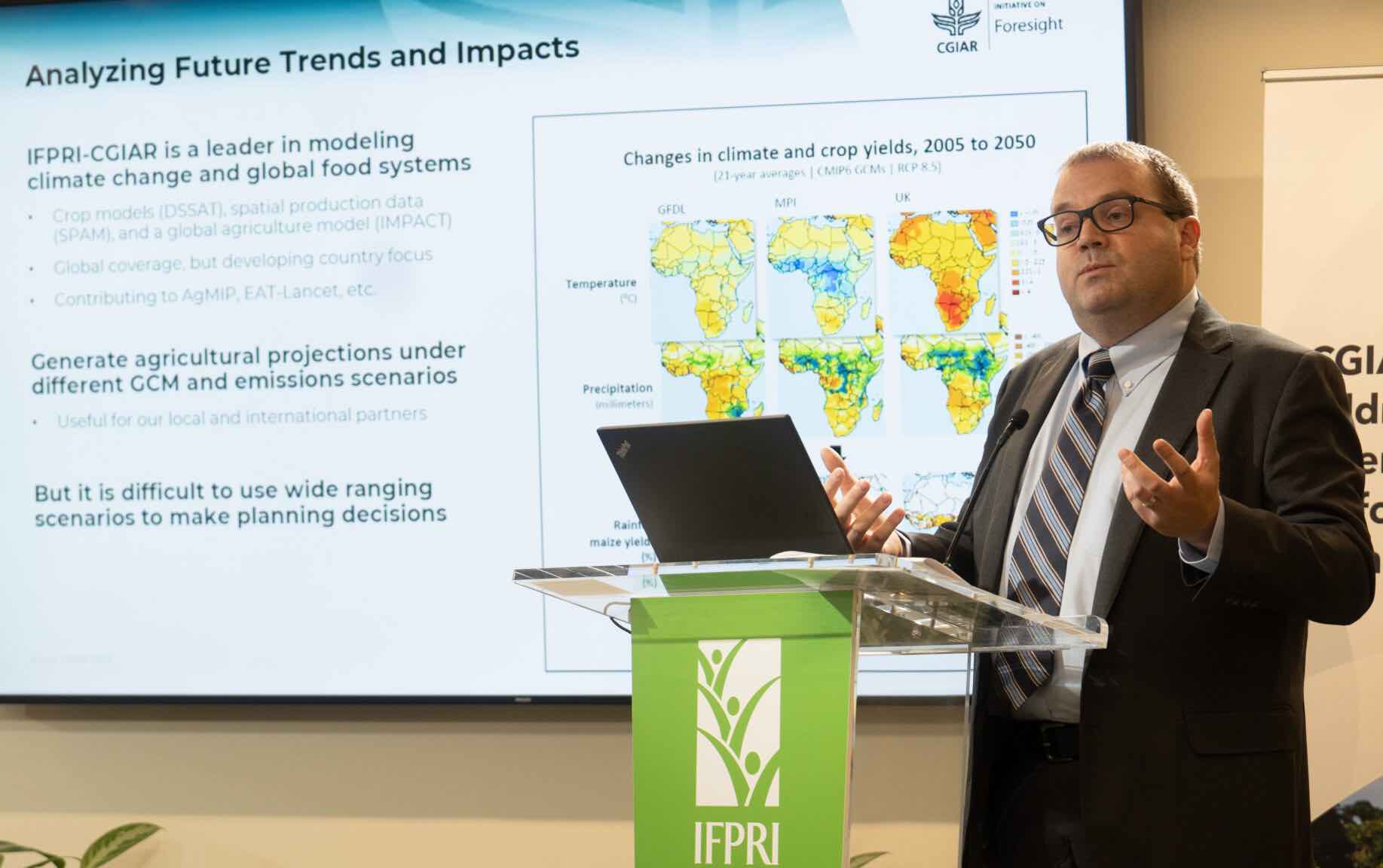Climate change poses significant challenges for global economic development and food systems, particularly for low-income countries and vulnerable populations. Policymakers are facing a daunting task of designing effective policies to address climate risks and making long-term investment decisions under growing uncertainty. Ideally, governments would have access to advance information about likely/estimated unfolding climate change patterns specific to their regions and the potential implications for their economies and communities. CGIAR is working to provide this kind of information and foresight analysis to its partners.
A May 9 Aim for Climate (AIM4C) Summit off-site event, hosted by IFPRI and CGIAR at IFPRI’s Washington headquarters, highlighted the need for greater funding for agrifood systems research and development and provided an opportunity to meet with climate scientists working on modeling impacts of climate change on crop productivity, food security, and livelihoods. In this post, we share a summary of our presentation on foresight, climate change, and agrifood systems made during this event. [See slides here.]
Modeling the impacts of climate change on global food systems
IFPRI serves as the hub for the CGIAR’s core foresight capabilities, working with the CGIAR Foresight Initiative, and housing a comprehensive suite of data and modeling systems. These systems allow us to estimate the likely impacts of climate change on global food systems and food security.
With high-resolution spatial crop models and databases, we can assess, pixel by pixel, the range of likely implications of climate change on food production across the globe. Our global market models consider not only possible impacts on food production and productivity, but also on food prices and consumer demand, providing a holistic understanding of the complex interplay between climate change and food systems.
Focusing on developing countries
While there are many models out there, what sets the IFPRI/CGIAR models apart is their particular attention to the food, land, and water systems of developing countries. By utilizing these models, our team generates agricultural projections under various emissions scenarios that are particularly relevant for developing countries.
Figure 1 shows results of our recent work utilizing the latest climate change projections. It demonstrates how changes in temperature and precipitation can impact crop yields, in this case rainfed maize yields across different regions in Africa. Such information can be extremely useful for partners who might lack access to ready-to-use climate change data, allowing them to integrate these insights into their own analyses and decision-making processes.
Figure 1
Navigating uncertainty: Climate variability and policy making
However, Figure 1 also makes it apparent that each scenario tells a different story of how climate change might unfold—from a hotter Africa on the right to less warming on the left. Policymakers face the challenge of incorporating these disparate scenarios into their planning processes. Should they prepare for the worst-case scenario or hope for the best? The inherent uncertainty complicates the mainstreaming of climate change into policy formulation and implementation.
Recognizing the importance of addressing climate variability and uncertainty, the CGIAR foresight modeling team and our research partners have embraced an uncertainty-based approach to climate change analysis. We have collaborated with MIT to develop and promote this methodology, which better captures the full spectrum of potential climate change projections, to more effectively assess vulnerabilities and inform policies tailored to the context of developing countries.
Probabilistic climate modeling: Turning uncertainty into measurable risk
Figure 2 shows the flow of information between the MIT and IFPRI modeling tools. The MIT model stands out for its probabilistic nature which provides a spectrum of climate projections from best to worst. The climate information derived from this model is then used in IFPRI’s crop and economic models.
Figure 2
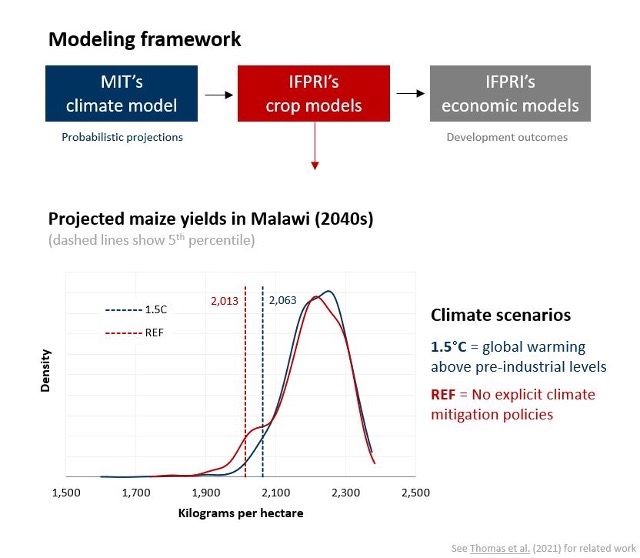
The figure shows an example of a crop modeling output resulting from this framework: in this case, the distribution of maize yields in Malawi under different climate projections. The most favorable climate projections lead to high maize yields of 2.4 tons per hectare, while less favorable conditions result in yields as low as 1.7 tons per hectare. These extreme outcomes however have low probabilities of occurrence. The bulk of projections center around an expected yield of 2.2 tons per hectare. Our approach turns climate uncertainty into risk, which is something we can factor into policy analysis and decision-making processes.
Testing the robustness of our policy recommendations
Historically, we have advised governments, especially those in the least developed countries, that agricultural growth is vital for reducing poverty. Agriculture’s vulnerability to climate raises concerns that favoring agriculture may expose economies to greater climate risks. Does climate variability warrant a reconsideration of our recommendation?
Figure 3 shows two future growth scenarios for Malawi. The first assumes agrifood system-driven growth, while the second emphasizes sectors outside of the food system. A leftward shift in the figure indicates a desirable decline in poverty.
Figure 3
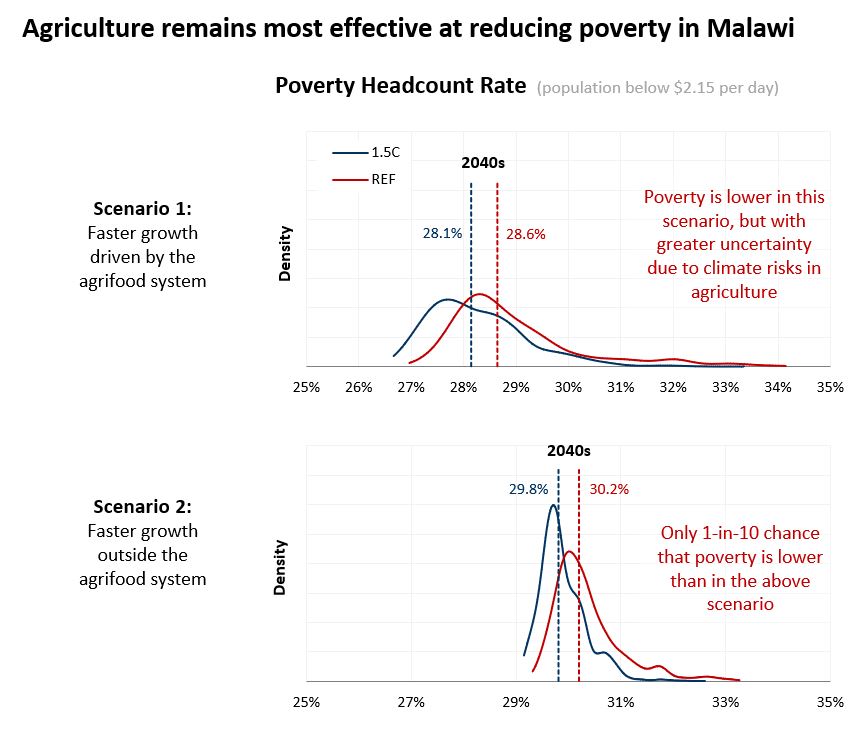
Four observations emerge from the figure:
- Even under a less severe climate change scenario (blue curve), climate variability leads to a wide range of possible poverty outcomes.
- Climate change exacerbates poverty (rightward shift to the red curve), posing challenges to development.
- Agriculture-led growth widens the range of poverty outcomes compared to growth in non-food sectors, reflecting increased exposure to risks in larger agricultural sectors.
- Importantly, however, the expected level of poverty is consistently lower under agriculture-led growth, except in 5%-10% of climate projections.
Thus, while climate risk introduces some uncertainty into the validity of our recommendation for agriculture-led growth, it remains a robust policy recommendation.
Evaluating risks outside agriculture
Climate risks to the food system extend beyond the direct impact on the agriculture sector. It is essential to consider the implications for other sectors, such as energy, which are integral to food processing and transport.
We use an integrated modeling framework (Figure 4) to consider multiple climate impact channels. This framework provides a comprehensive tool for evaluating the consequences of climate change, including temperature, precipitation, evaporation, and weather patterns, on various aspects of food systems and the economy.
Figure 4
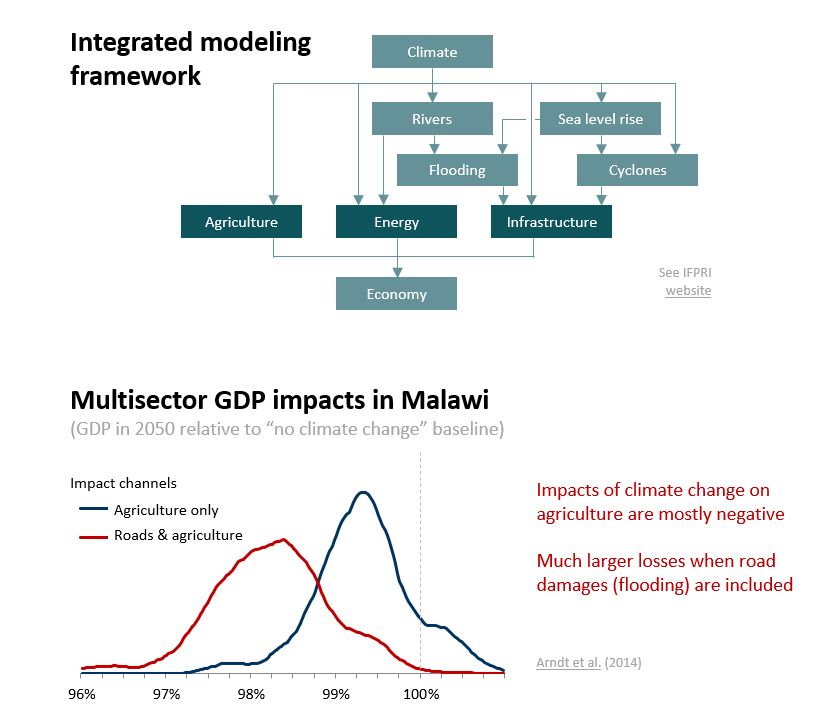
The graph demonstrates the impact of considering broader climate impacts. The blue distribution shows the impact on real GDP when solely considering climate change’s effects on the agriculture sector. In contrast, the red distribution incorporates climate impacts on road infrastructure as well. A leftward shift in the distribution signifies a negative impact on real GDP.
This result emphasizes that addressing food system risks solely through agricultural policies is limited. It calls for enhanced policy coordination across sectors to minimize the adverse consequences of climate change.
More frequent extreme events
Policymakers are increasingly concerned about the severity and frequency of extreme events, such as floods or droughts, in addition to long-term climate changes. Our research indicates that extreme events will become more frequent in the future.
Figure 5 shows an example for Southern Africa where 1-in-20-year low-yield event for rainfed maize could become 1-in-5-year events by 2060 if no explicit climate mitigation policies are implemented.
Figure 5
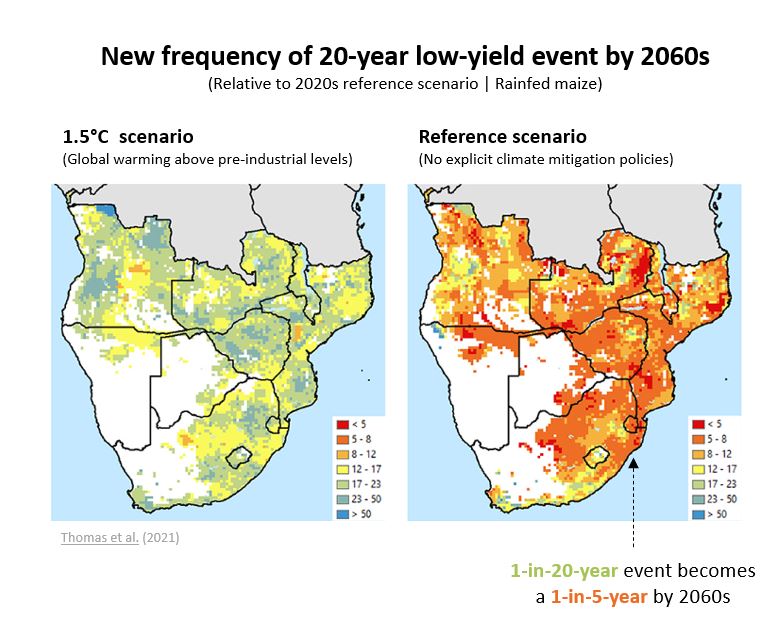
While the impact of climate change across the region is not uniform, the general increase in extreme event frequency raises concerns about the likelihood of simultaneous similar events across different countries, leading to multi-breadbasket failures.
Climate research to address global food system challenges
Our foresight team’s climate work extends beyond the examples provided. We also focus on climate mitigation, energy policy, and understanding the impacts on broader indicators including youth employment, livelihoods, and dietary patterns. Crucially, we collaborate with local research partners and decision-makers to enhance strategies and policies on the ground. The expanding scope of climate research across CGIAR reflects the growing complexity of global food system challenges and our commitment to ensure that a wide range of climate risks are considered in today’s policy decisions.
James Thurlow is Director and Faaiqa Hartley is Scientist with IFPRI’s Foresight and Policy Modeling Unit. Both authors are actively involved with the CGIAR Foresight Initiative. Authors are grateful to Evgeniya Anisimova and Keith Wiebe for revisions and contributions to this post. This post also appears on the CGIAR website.




